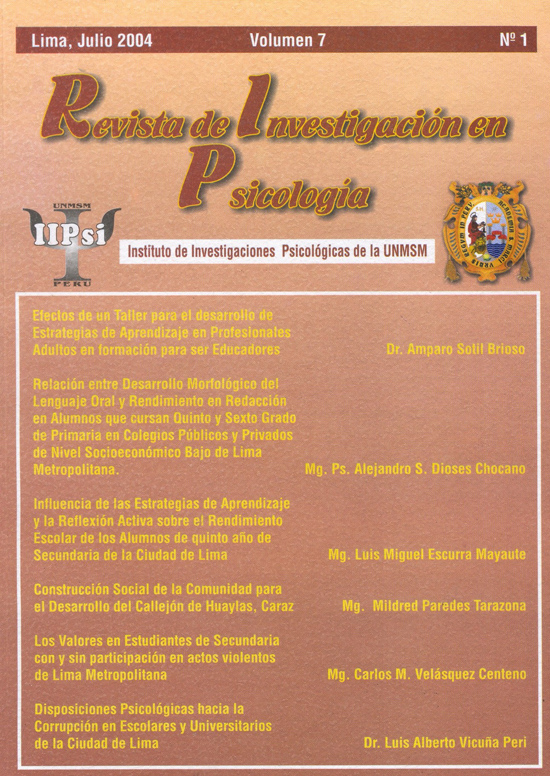Psychological dispositions towards the corruption in students and college students of the city of Lima
DOI:
https://doi.org/10.15381/rinvp.v7i1.5143Keywords:
style, attribution, optimist, explanatory, corruptionAbstract
OBJECTIVE: to know the dispositions psychological, in terms of the explanatory atribucional style towards the corruption in students and college students in function to sex and the chronological age. DESIGN: the study is descriptive cross-sectional comparative. MATERIAL And METHODS: the knowledge of the atribucional style, is the resultant of the combination of three dimensions: externalidad, instability and specificity, were by means of the application of test ASQ-C1DE, of Peterson, adapted towards the corrupt acts, the validity was by the method of content analysis, and the trustworthiness by the method of the test retest. The mentioned test was applied in collective form to non greater groups of twenty-five per time, to a sample selected by layers, students of the secondary level and university, with a margin of error of a 0,05 and level of confidence of the 0.95. RESULTS: the tendency of the studied sample is towards the Internally, instability and specificity that corresponds to the optimistic explanatory style in a 73 percent, whereas the 27 percent shows tendency towards the pessimistic explanatory style towards the corrupt acts. CONCLUSIONS: In the Externally dimension ¬Internally the chronological age raises significant differences, to smaller age greater Externalidad. In the dimension Stability -Instability, also the chronological age raises significant differences where to smaller age there is greater Instability In the dimension Specificity - Totality the chronological age does not raise significant differences, the group as a whole tends towards the Specificity. Finally, sex does not raise differences in the mentioned dimensions, reason why it is encouraging that our young people are optimists to face the corruption acts.Downloads
Published
Issue
Section
License
Copyright (c) 2004 Luis Vicuña Peri, Héctor Hernández Valz, José Ríos Diaz, Juan Carlos Quiliche Vargas, Christian Santillana Piscoya, Edgar Sarmiento Barrenechea, Antoni Timoteo Jiménez, Dick Palomino Cueva, Jassin Noe Retamozo, Miguel Camarena Munguia, Jenny Torres Malca

This work is licensed under a Creative Commons Attribution-NonCommercial-ShareAlike 4.0 International License.
THE AUTHORS RETAIN THEIR RIGHTS:
a. The authors retain their trademark and patent rights, and also on any process or procedure described in the article.
b. The authors retain the right to share, copy, distribute, execute and publicly communicate the article published in the Journal of Research in Psychology (for example, place it in an institutional repository or publish it in a book), with acknowledgment of its initial publication in the Journal of Research in Psychology.
c. Authors retain the right to make a subsequent publication of their work, to use the article or any part of it (for example: a compilation of their work, lecture notes, thesis, or for a book), provided that they indicate the source. of publication (authors of the work, magazine, volume, number and date).






